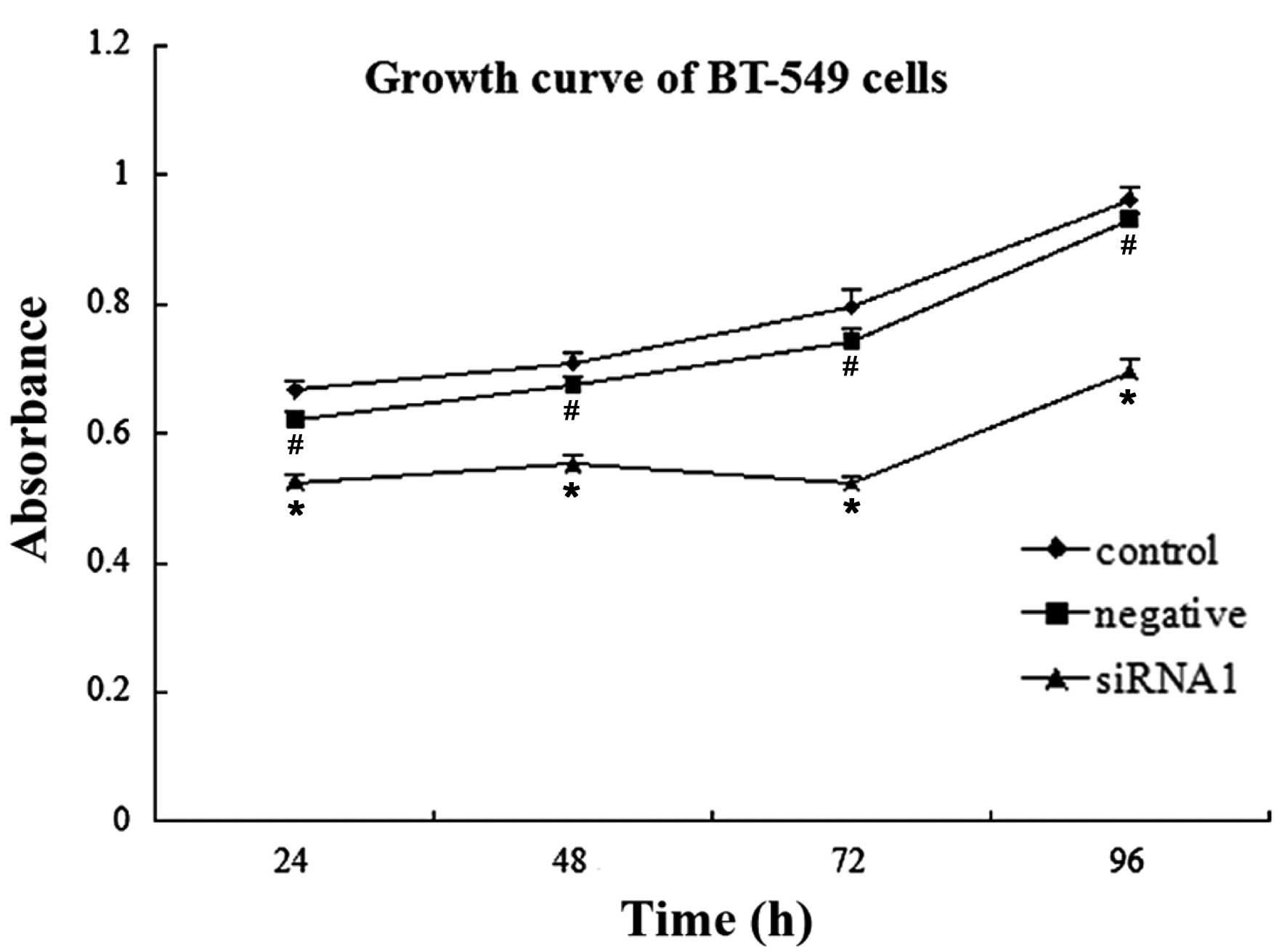|
1
|
Yamamoto Y, Huibregtse JM and Howley PM:
The human E6-AP gene (UBE3A) encodes three potential protein
isoforms generated by differential splicing. Genomics. 41:263–266.
1997. View Article : Google Scholar : PubMed/NCBI
|
|
2
|
Scheffner M, Huibregtse JM, Vierstra RD
and Howley PM: The HPV-16 E6 and E6-AP complex functions as a
ubiquitin-protein ligase in the ubiquitination of p53. Cell.
75:495–505. 1993. View Article : Google Scholar : PubMed/NCBI
|
|
3
|
Khan OY, Fu G, Ismail A, et al:
Multifunction steroid receptor coactivator, E6-associated protein,
E6-AP is involved in development of the prostate gland. Mol
Endocrinol. 20:544–559. 2006. View Article : Google Scholar
|
|
4
|
Xiu XX, Zhang SL, Lu XY, Liang MY, Yu J
and Hou JP: SiRNA inhibition of E6AP expression in cervical cancer
cells. Zhonghua Bing Li Xue Za Zhi. 37:822–825. 2008.In
Chinese.
|
|
5
|
Ramamoorthy S, Tufail R, Hokayem JE, et
al: Overexpression of ligase defective E6-associated protein,
E6-AP, results in mammary tumorigenesis. Breast Cancer Res Treat.
132:97–108. 2012. View Article : Google Scholar
|
|
6
|
Deng S, Zhou H, Xiong R, et al:
Over-expression of genes and proteins of ubiquitin specific
peptidases (USPs) and proteasome subunits (PSs) in breast cancer
tissue observed by the methods of RFDD-PCR and proteomics. Breast
Cancer Res Treat. 104:21–30. 2007. View Article : Google Scholar
|
|
7
|
Liu X, Disbrow GL, Yuan H, Tomaic V and
Schlegel R: Myc and human papillomavirus type 16 E7 genes cooperate
to immortalize human keratinocytes. J Virol. 81:12689–12695. 2007.
View Article : Google Scholar : PubMed/NCBI
|
|
8
|
Liu X, Yuan H, Fu B, et al: The E6AP
ubiquitin ligase is required for transactivation of the hTERT
promoter by the human papillomavirus E6 oncoprotein. J Biol Chem.
280:10807–10816. 2005. View Article : Google Scholar : PubMed/NCBI
|
|
9
|
Mishra A, Godavarthi SK and Jana NR:
UBE3A/E6-AP regulates cell proliferation by promoting proteasomal
degradation of p27. Neurobiol Dis. 36:26–34. 2009. View Article : Google Scholar : PubMed/NCBI
|
|
10
|
Shimoji T, Murakami K, Sugiyama Y, et al:
Identification of annexin A1 as a novel substrate for E6AP-mediated
ubiquitylation. J Cell Biochem. 106:1123–1135. 2009. View Article : Google Scholar : PubMed/NCBI
|
|
11
|
Ramamoorthy S, Dhananjayan SC, Demayo FJ
and Nawaz Z: Isoform-specific degradation of PR-B by E6-AP is
critical for normal mammary gland development. Mol Endocrinol.
24:2099–2113. 2010. View Article : Google Scholar : PubMed/NCBI
|
|
12
|
Lokman NA, Ween MP, Oehler MK and
Ricciardelli C: The role of annexin A2 in tumorigenesis and cancer
progression. Cancer Microenviron. 4:199–208. 2011. View Article : Google Scholar : PubMed/NCBI
|
|
13
|
Sharma MR, Koltowski L, Ownbey RT,
Tuszynski G and Sharma MC: Angiogenesis-associated protein annexin
II in breast cancer: selective expression in invasive breast cancer
and contribution to tumor invasion and progression. Exp Mol Pathol.
81:146–156. 2006. View Article : Google Scholar : PubMed/NCBI
|
|
14
|
Deng S, Jing B, Xing T, Hou L and Yang Z:
Overexpression of annexin A2 is associated with abnormal
ubiquitination in breast cancer. Genomics Proteomics
Bioinformatics. 10:153–157. 2012. View Article : Google Scholar : PubMed/NCBI
|
|
15
|
Ramamoorthy S and Nawaz Z: E6-associated
protein (E6-AP) is a dual function coactivator of steroid hormone
receptors. Nucl Recept Signal. 6:e0062008.PubMed/NCBI
|
|
16
|
Yamasaki L and Pagano M: Cell cycle,
proteolysis and cancer. Curr Opin Cell Biol. 16:623–628. 2004.
View Article : Google Scholar : PubMed/NCBI
|
|
17
|
Micel LN, Tentler JJ, Smith PG and
Eckhardt GS: Role of ubiquitin ligases and the proteasome in
oncogenesis: novel targets for anticancer therapies. J Clin Oncol.
31:1231–1238. 2013. View Article : Google Scholar : PubMed/NCBI
|
|
18
|
Dees EC and Orlowski RZ: Targeting the
ubiquitin-proteasome pathway in breast cancer therapy. Future
Oncol. 2:121–135. 2006. View Article : Google Scholar : PubMed/NCBI
|
|
19
|
Spänkuch-Schmitt B, Bereiter-Hahn J,
Kaufmann M and Stredhardt K: Effect of RNA sileneing of polo-like
kinase-1 (PLK1) on apoptosis and spindle formation in human cancer
cells. J Natl Cancer Inst. 94:1863–1877. 2002. View Article : Google Scholar
|
|
20
|
Liu S and Chen ZJ: Expanding role of
ubiquitination in NF-κB signaling. Cell Res. 21:6–21. 2011.
View Article : Google Scholar
|
|
21
|
Adhikari A and Chen ZJ: Diversity of
polyubiquitin chains. Dev Cell. 16:485–486. 2009. View Article : Google Scholar : PubMed/NCBI
|
|
22
|
Sadowski M, Suryadinata R, Tan AR, Roesley
SN and Sarcevic B: Protein monoubiquitination and
polyubiquitination generate structural diversity to control
distinct biological processes. IUBMB Life. 64:136–142. 2012.
View Article : Google Scholar
|
|
23
|
Lochab S, Pal P, Kanaujiya JK, et al:
Proteomic identification of E6AP as a molecular target of tamoxifen
in MCF7 cells. Proteomics. 12:1363–1377. 2012. View Article : Google Scholar : PubMed/NCBI
|
|
24
|
Srinivasan S and Nawaz Z: E3 ubiquitin
protein ligase, E6-associated protein (E6-AP) regulates PI3K-Akt
signaling and prostate cell growth. Biochim Biophys Acta.
1809:119–127. 2011. View Article : Google Scholar :
|
|
25
|
Jiang YH, Armstrong D, Albrecht U, et al:
Mutation of the Angelman ubiquitin ligase in mice causes increased
cytoplasmic p53 and deficits of contextual learning and long-term
potentiation. Neuron. 21:799–811. 1998. View Article : Google Scholar : PubMed/NCBI
|
|
26
|
Mishra A and Jana NR: Regulation of
turnover of tumor suppressor p53 and cell growth by E6-AP, a
ubiquitin protein ligase mutated in Angelman mental retardation
syndrome. Cell Mol Life Sci. 65:656–666. 2008. View Article : Google Scholar : PubMed/NCBI
|














